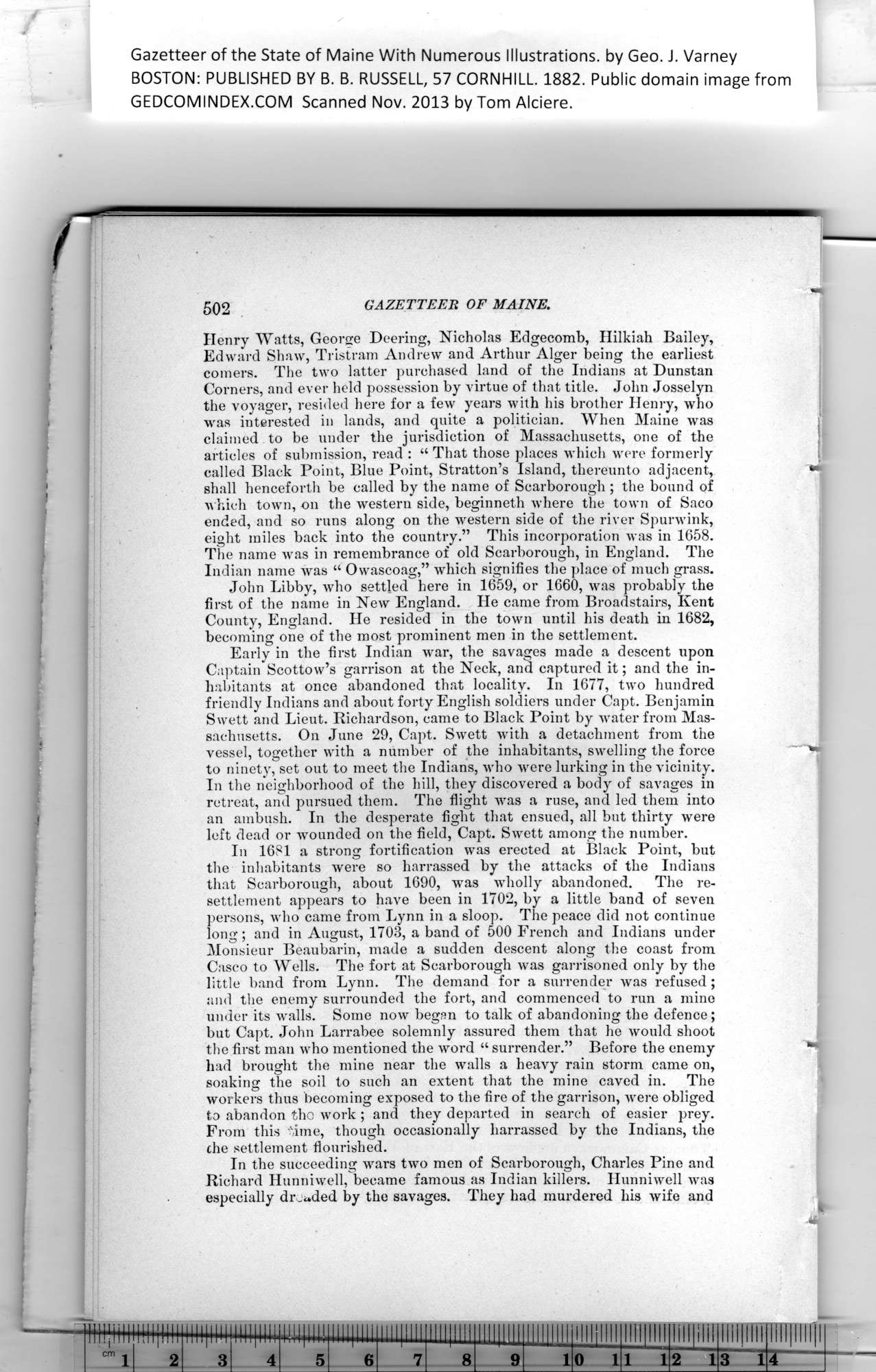|
Gazetteer of the State of Maine With Numerous Illustrations, by Geo. J. Varney
BOSTON: PUBLISHED BY B. B. RUSSELL, 57 CORNHILL. 1882. Public domain image from
502 GAZETTEER OF MAINE.
Henry Watts, George Deering, Nicholas Edgecomb, Hilkiah Bailey,
Edward Shaw, Tristram Andrew and Arthur Alger being the earliest
comers. The two latter purchased land of the Indians at Dunstan
Corners, and ever held possession by virtue of that title. John Josselyn
the voyager, resided here for a few years with his brother Henry, who
was interested in lands, and quite a politician. When Maine was
claimed, to be under the jurisdiction of Massachusetts, one of the
articles of submission, read : “ That those places which were formerly
called Black Point, Blue Point, Stratton’s Island, thereunto adjacent,
shall henceforth be called by the name of Scarborough; the bound of
which town, on the western side, beginneth where the town of Saco
ended, and so runs along on the western side of tbe river Spurwink,
eight miles back into the country.” This incorporation was in 1658.
The name was in remembrance of old Scarborough, in England. The
Indian name tvas “ Owascoag,” which signifies the place of much grass.
John Libby, who settled here in 1659, or 1660, was probably the
first of the name in New England. He came from Broadstairs, Kent
County, England. He resided in the town until his death in 1682,
becoming one of the most prominent men in the settlement.
Early in the first Indian war, the savages made a descent upon
Captain Scottow’s garrison at the Neck, and captured it; and the in-
habitants at once abandoned that locality. In 1677, two hundred
friendly Indians and about forty English soldiers under Capt. Benjamin
Swett and Lieut. Richardson, came to Black Point by water from Mas-
sachusetts. On June 29, Capt. Swett with a detachment from the
vessel, together with a number of the inhabitants, swelling the force
to ninety, set out to meet the Indians, who were lurking in the vicinity.
In the neighborhood of the hill, they discovered a body of savages in
retreat, and pursued them. The flight was a ruse, and led them into
an ambush. In the desperate figlit that ensued, all but thirty were
left dead or wounded on the field, Capt. Swett among the number.
In 1681 a strong fortification was erected at Black Point, but
the inhabitants were so harrassed by the attacks of the Indians
that Scarborough, about 1690, was wholly abandoned. The re-
settlement appears to have been in 1702, by a little band of seven
persons, wlio came from Lynn in a sloop. The peace did not continue
long; and in August, 1703, a band of 500 French and Indians under
Monsieur Beaubarin, made a sudden descent along the coast from
Casco to Wells. The fort at Scarborough was garrisoned only by the
little band from Lynn. The demand for a surrender was refused;
and the enemy surrounded the fort, and commenced to run a mine
under its walls. Some now began to talk of abandoning the defence;
but Capt. John Larrabee solemnly assured them that he would shoot
the first man who mentioned the word “ surrender.” Before the enemy
had brought the mine near the walls a heavy rain storm came on,
soaking the soil to such an extent that the mine caved in. The
workers thus becoming exposed to the fire of the garrison, were obliged
to abandon the work ; and they departed in search of easier prey.
From this time, though occasionally harrassed by the Indians, the
the settlement flourished.
In the succeeding wars two men of Scarborough, Charles Pine and
Richard Hunniwell, became famous as Indian killers. Hunniwell was
especially drouded by the savages. They had murdered his wife and
PREVIOUS PAGE ... NEXT PAGE
This page was written in HTML using a program written in Python 3.2
|
